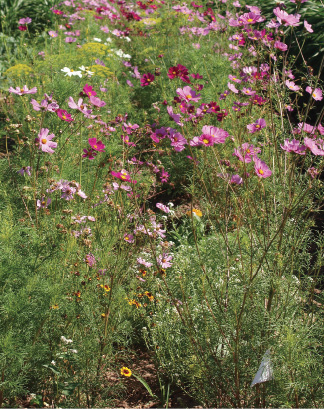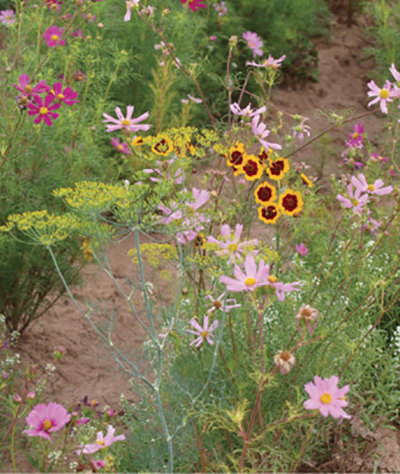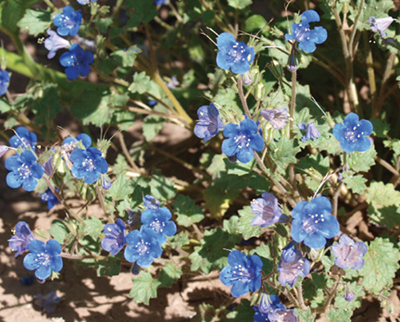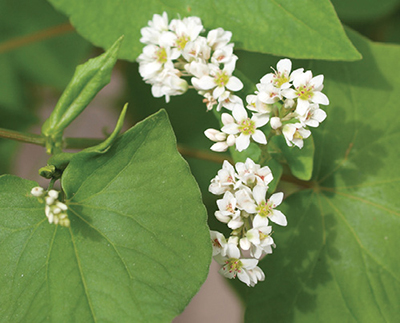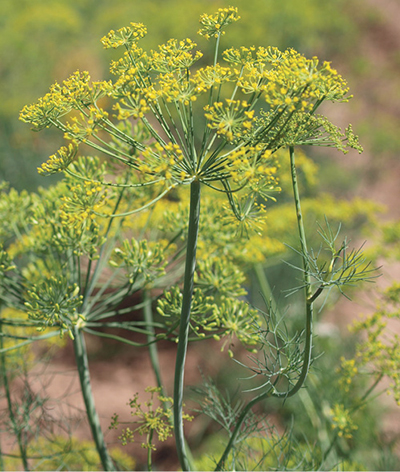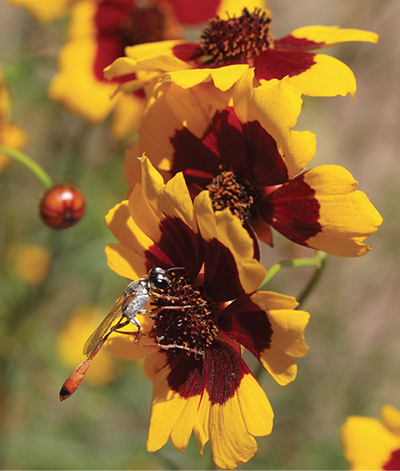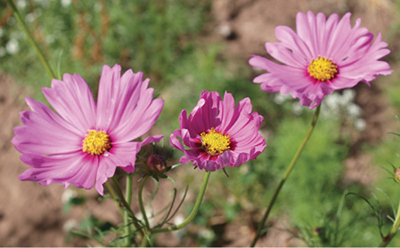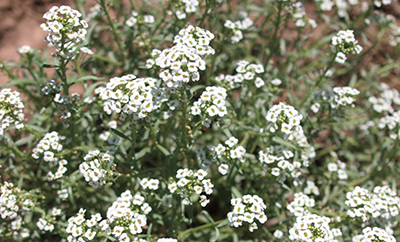Guide H-169
Revised by Ashley Bennett
College of Agricultural, Consumer and Environmental Sciences, New Mexico State University
Author: Small Urban Farm IPM Specialist, Department of Extension Plant Sciences, New Mexico State University.(Print Friendly PDF)
Introduction
There are many naturally occurring predatory and parasitic insects (and related species) that can help reduce pest populations on farms and in gardens. These biological control agents include various parasitic wasps and flies, minute pirate bugs, hoverflies, green lacewings, ambush bugs, ladybird beetles, crab spiders, and predatory mites1. In order to maximize the impact of beneficial species, they should be protected from exposure to pesticides by practicing integrated pest management (IPM)2. In addition, beneficial insect populations can be encouraged by growing flowering plants that provide nectar and pollen. Floral resources are essential to supporting beneficial insects because some predators and parasitoids are only predaceous in one life stage, meaning life stages that are not predaceous feed on pollen and nectar. For example, parasitic wasps are predaceous during the larval stage, but as adults they visit flowers for nectar. Floral resources also help sustain beneficial insects when prey is scarce, increasing their lifespan and level of egg production.
The goal of developing mixtures of “insectary” plants is to provide nectar and pollen all season long. Because beneficial insects differ in the size and structure of their mouthparts, not all flowers are equally accessible (or valuable) to all species. The flower mixture should contain a diversity of plant species with different bloom periods, flower sizes, flower shapes (e.g. tubular vs. disk), and colors in order to benefit the maximum number of beneficial insects (Figure 1). Several companies offer commercial seed mixes designed for this purpose, but these mixtures do not always perform consistently well in different regions or climates. When identifying mixes, make sure to target species appropriate for the climate and soil at your location.
Figure 1a. Insectary mixtures in full bloom.
Figure 1b. Insectary mixtures in full bloom.
When selecting species to plant, the primary goal is to maximize the abundance and diversity of flowering across the growing season. Ideally, the species selected should be cheap, readily available, easy to grow, and quick to bloom. Annual species have the advantage over perennials of being quick to establish, readily producing flowers, and are easy to rotate in different areas of the farm or garden in successive years. For these reasons, a mixture of common garden flowers and herbs often works well for enhancing populations of beneficial insects. In addition, many ornamentals and herbs are available from organic seed suppliers for certified organic producers. Plantings intended mainly for native pollinators (e.g. native bees and butterflies) require a different approach3, specifically using flowers native to the region.
Seed Mixes
Research conducted at NMSU’s Los Lunas Agricultural Science Center evaluated annual mixtures targeting beneficial insects. The most successful mixture contained quick-growing annuals that significantly increased several groups of insect predators and parasitoids important to IPM. Seeds for the recommended mixture are all readily available, relatively cheap, and easy to grow. In our experiments, the below mixture survived well in both sandy and clay soils, bloomed from late June to early October, and required minimal care (i.e., regular watering and weeding during establishment). This mixture can also be used as a starting point to develop more complex blends by adding additional species (with appropriate adjustment of seeding rates). If additional species are added to the core mixture, select single-flowered varieties rather than the more ornamental “double” varieties since the nectar and pollen in the latter are often difficult for insects to access. Insectary plants also have the potential to attract pest insects. When developing mixtures consider excluding flowers in the same botanical family as your crop. Sweet alyssum, for example, is part of the cabbage family (Brassicaceae) and can attract pests of crops in this family (e.g., flea beetles, harlequin bugs [Murgantia histrionica], and Bagrada bugs [Bagrada hilaris]). If growing brassica crops, such as arugula, mustard greens, kale, or Chinese cabbage, consider omitting alyssum.
Our suggested mixture consists of California bluebell (Phacelia campanularia), buckwheat (Fagopyrum esculentum), dill (Anethum graveolens), plains coreopsis (Coreopsis tinctoria), garden cosmos (Cosmos bipinnatus), and sweet alyssum (Lobularia maritima) (Figures 2 through 7). With the exception of California bluebell, all flower for most of the season in New Mexico. California bluebell will usually set seed and die by the middle of summer, but is included because it is one of the earliest species to bloom. Including very early spring and late fall flowering species is critical to providing valuable early and late season food resources for beneficial insects. In our trials, the following species performed poorly and are not recommended, although they may perform better in other areas: California poppy (Eschscholzia californica), cornflower (Centaurea cyanus), coriander (Coriandrum sativum), garland daisy (Chrysanthemum coronarium), nodding catchfly (Silene pendula), tidy tips (Layia platyglossa), and English or pot marigold (Calendula officinalis). We also found that buckwheat, although a very valuable insectary plant, can be highly susceptible to root rot caused by the fungus Rhizoctonia solani (especially in sandy soils). As a result, avoid this species if your soil is known to contain this pathogen.
Figure 2. California bluebell (Phacelia campanularia).
Figure 3. Buckwheat (Fagopyrum esculentum).
Figure 4. Dill (Anethum graveolens).
Figure 5. Plains coreopsis (Coreopsis tinctoria).
Figure 6. Garden cosmos (Cosmos bipinnatus).
Figure 7. Sweet alyssum (Lobularia maritima).
Cultural Guidelines
Insectary plants should be sown in spring after the danger of frost has past, and if possible in advance of the crop(s) to be protected. The seeds in our suggested mixture vary greatly in size, making it difficult to use a mechanical seeder. For small areas, the seeds can be mixed with dry peat and broadcast by hand over a prepared seedbed. The mixture should be lightly incorporated into the soil prior to watering. Since some of the seeds are very small, mixing them with a much larger volume of peat helps ensure a more even distribution across the bed and makes it easy to see which parts have been sown. For larger areas, an alternative approach would be to mechanically sow each species in single rows within a wider bed, although this would require more space and more seed.
Reputable seed companies should be able to provide suggested seeding rates for different species. In our plantings, we sowed each species at twice the recommended seeding rate (to compensate for difficult spring germination and establishment conditions) divided by the total number of species in the mix. It may be necessary to adjust this basic guideline for individual species in different situations. Garden cosmos, for example, can be aggressive when grown in clay soils. Under these conditions, cosmos should be sown at half the normal seeding rate to avoid this flower dominating the mix and shading out the other, lower-growing species.
Below is an example showing the calculations to determine the weight of seed needed for one species. In this example, dill is combined with five other species, resulting in a six-species mix. The calculation is for one row 10 inches wide by 50 feet long. Table 1 shows the weight of seed needed for each of the remaining species in the mix to sow this area. Once all the seeds are weighed, they should be combined and thoroughly mixed with 8 to 10 liters of dry peat for broadcasting by hand. Since seeding rates are normally expressed in pounds per acre, this was used as a starting point, but final weights are also given in grams to facilitate weighing small quantities.
Example Calculation of Weight of Seed Needed Area: One 10-inch-wide row (0.83 ft) × 50 ft = 41.5 ft2 = 0.000953 acre
Species: Dill
Normal seeding rate: 8 lb per acre
Twice normal seeding rate = (2 × 8) = 16 lb per acre
Twice normal seeding rate divided by total number of species in mixture = Fractional seeding rate = 16 ÷ 6 = 2.7 lb per acre
Fractional seeding rate in ounces = 2.7 × 16 = 43.2 ounces per acre
Fractional seeding rate multiplied by row area = 43.2 × 0.000953 acre = 0.041 ounce (1.16 grams)
This is the amount of dill seed needed for a single row 10 inches wide by 50 feet long, as part of a six-species mix.
|
Table 1. Weight of Seed Needed for Each of the Six Species in the Suggested Core Mix for One Row 10 Inches Wide by 50 Feet Long (0.000953 acres) |
||||||
|
Species |
Seeding rate |
Twice normal seeding rate |
Fractional seeding rate for six-species mix (lb per acre) |
Fractional seeding rate for |
Fractional seeding rate multiplied by row area (= weight of seed needed for one row, in ounces) |
Weight of seed needed for one row (grams) |
|
California bluebell (Phacelia campanularia) |
3 |
6 |
1 |
16 |
0.015 |
0.43 |
|
Buckwheat (Fagopyrum esculentum) |
70 |
140 |
23.3 |
372.8 |
0.355 |
10.06 |
|
Dill |
8 |
16 |
2.7 |
43.2 |
0.041 |
1.16 |
|
Plains coreopsis |
2 |
4 |
0.7 |
11.2 |
0.011 |
3.12 |
|
Garden cosmos |
30 |
60 |
10 |
160 |
0.153 |
4.34 |
|
Sweet alyssum |
2 |
4 |
0.7 |
11.2 |
0.011 |
0.31 |
1See Pocket Guide to the Beneficial Insects of New Mexico, available at http://aces.nmsu.edu/pubs/insects/docs/Beneficial_Insects.pdf
2See NMSU Extension Circular 655, Integrated Pest Management (IPM) for Home Gardeners, available at http://aces.nmsu.edu/pubs/_circulars/CR655.pdf
3See USDA–NRCS Plant Materials Technical Note No. 71 (Final Revision), Pollinator Plant Recommendations for New Mexico, available at https://www.nrcs.usda.gov/Internet/FSE_PLANTMATERIALS/publications/nmpmctn12632.pdf
For further reading
H-110: Backyard Composting
https://pubs.nmsu.edu/_h/H110/
H-168: Selection and Use of Insecticides for Organic Production
https://pubs.nmsu.edu/_h/H168/
CR-655: Integrated Pest Management (IPM) for Home Gardeners
https://pubs.nmsu.edu/_circulars/CR655/
Ashley Bennett is the Urban and Small Farm IPM Specialist at NMSU. She earned her Ph.D. in entomology from the University of Wisconsin. Her research focuses on improving the design of urban and agricultural landscapes to conserve beneficial insects and increase their ecosystem services, including developing native plant mixes to support beneficial insects, improving site selection for urban agriculture, and using drone technology to improve IPM.
To find more resources for your business, home, or family, visit the College of Agricultural, Consumer and Environmental Sciences on the World Wide Web at pubs.nmsu.edu
Contents of publications may be freely reproduced for educational purposes. All other rights reserved. For permission to use publications for other purposes, contact pubs@nmsu.edu or the authors listed on the publication.
New Mexico State University is an equal opportunity/affirmative action employer and educator. NMSU and the U.S. Department of Agriculture cooperating.
Revised February 2018 Las Cruces, NM


